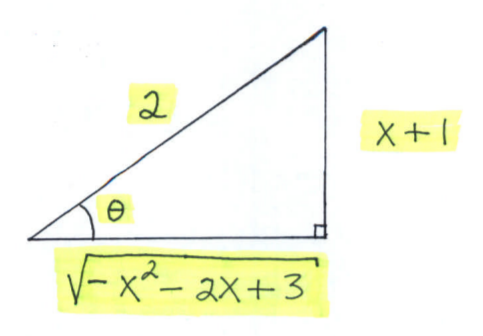SOLUTION 16: $ \ \ $ Integrate $ \displaystyle{ \int {
\sqrt{1-x} \cdot \sqrt{x+3} } \ dx } $. Begin by rewriting the integrand.
$$ \displaystyle{ \int { \sqrt{1-x} \cdot \sqrt{x+3} } \ dx }
= \displaystyle{ \int { \sqrt{-x^2-2x+3} } \ dx } $$
$$ = \displaystyle{ \int { \sqrt{-(x^2+2x)+3} } \ dx } $$
(Now complete the square.)
$$ = \displaystyle{ \int { \sqrt{-(x^2+2x+1)+3+1} } \ dx } $$
$$ = \displaystyle{ \int { \sqrt{4-(x+1)^2} } \ dx } $$
Now use the trig substitution
$$ x+1 = 2 \sin \theta $$
so that
$$ dx = 2 \cos \theta \ d \theta $$
Substitute into the original problem, replacing all
forms of $ x $, getting
$$ \displaystyle{ \int { \sqrt{4-(x+1)^2} } \ dx }
= \displaystyle{ \int \sqrt{ 4- (2 \sin \theta)^2 } \cdot 2 \cos \theta \ d \theta } $$
$$ = 2 \displaystyle{ \int \sqrt{ 4- 4 \sin^2 \theta } \cos \theta \ d \theta } $$
$$ = 2 \displaystyle{ \int \sqrt{ 4(1- \sin^2 \theta) } \cos \theta \ d \theta } $$
$$ = 2 \displaystyle{ \int \sqrt{ 4 \cos^2 \theta } \cos \theta \ d \theta } $$
$$ = 2 \displaystyle{ \int 2 \cos \theta \cdot \cos \theta \ d \theta } $$
$$ = 4 \displaystyle{ \int \cos^2 \theta \ d \theta } $$
(Recall that $ \cos^2 \theta = (1/2)(1+ \cos 2 \theta) $.)
$$ = 4 \displaystyle{ \int \frac{1}{2}(1+ \cos 2 \theta) \ d \theta } $$
$$ = 2 \displaystyle{ \int (1+ \cos 2 \theta) \ d \theta } $$
$$ = 2 \displaystyle{ ( \theta + \frac{1}{2} \sin 2 \theta ) } + C $$
(Recall that $ \sin 2 \theta = 2 \sin \theta \cos \theta $.)
$$ = 2 \displaystyle{ \Big( \theta + \frac{1}{2} (2 \sin \theta \cos \theta) \Big) } + C $$
$$ = 2 \displaystyle{ ( \theta + \sin \theta \cos \theta ) } + C $$
$$ = \displaystyle{ 2\theta + 2\sin \theta \cos \theta } + C $$
$\Big($ We need to write our final answer in terms of $x$.

Since
$$ x+1 = 2 \sin \theta $$
it follows that
$$ \sin \theta = \frac{ x+1 }{ 2 } = \displaystyle{ opposite \over hypotenuse } $$
and
$$ \theta = \arcsin \frac{x+1}{2} $$
and from the Pythagorean Theorem that
$$ (adjacent)^2 + (opposite)^2 = (hypotenuse)^2 \ \ \longrightarrow $$
$$ (adjacent)^2 + (x+1)^2 = (2)^2 \ \ \longrightarrow \ \ \ adjacent = \sqrt{4-(x+1)^2} = \sqrt{-x^2-2x+3} \ \ \longrightarrow $$
$$ \cos \theta = \displaystyle{ adjacent \over hypotenuse}
= \frac{ \sqrt{-x^2-2x+3} }{ 2 } . \Bigg) $$
$$ = \displaystyle { 2 \arcsin \frac{x+1}{2} + 2 \cdot \frac{ x+1 }{ 2 } \frac{ \sqrt{-x^2-2x+3} }{ 2 } } $$
$$ = \displaystyle { 2 \arcsin \frac{x+1}{2} + \frac{ x+1 }{ 2 } \sqrt{-x^2-2x+3} } $$
Click HERE to return to the list of problems.

